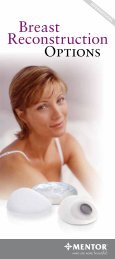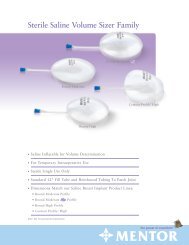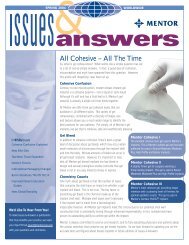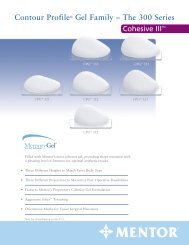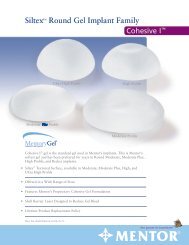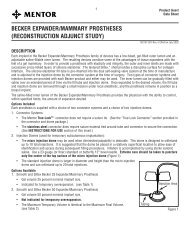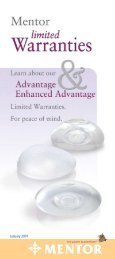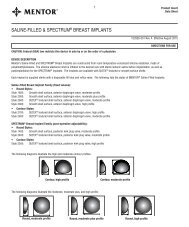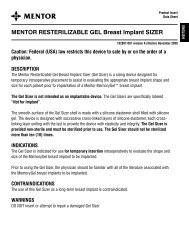Breast Reconstruction Patients Educational Brochure - Mentor
Breast Reconstruction Patients Educational Brochure - Mentor
Breast Reconstruction Patients Educational Brochure - Mentor
- No tags were found...
Create successful ePaper yourself
Turn your PDF publications into a flip-book with our unique Google optimized e-Paper software.
437.3 Caring for Yourself in the Months and Years after SurgeryThere are some things you should do to make sure your breasts stay healthy and to takecare of your implants: mammograms, breast exams, and protecting your implants fromcertain types of damage. It will be important to monitor your breasts for breast cancer.Also monitor regularly for breast implant rupture.MammogramsMammograms of a reconstructed breast are not usually performed. The following mayapply to the contralateral breast, if an implant is present, or to the reconstructed breast ifit is being imaged:A mammogram is a special way of x-raying the breast. Whether or not you have breastimplants, having a mammogram is considered the best way to detect breast cancer.However, there are some special considerations for women with breast implants:• <strong>Breast</strong> implants can make it harder to see breast cancer on a mammogram.• <strong>Breast</strong> implants can make it harder for the technologist to perform the mammogram.The machine that does a mammogram squeezes the breast to make it as flat as possiblewhile taking a picture. The pressure from this squeezing could make your implant ruptureor cause gel bleed. You must tell the technologist that you have silicone gel breast implantsbefore the procedure. The technologist can then use special techniques to get the bestpossible views of your breast tissue. He or she can also take steps to reduce the likelihoodthat your implants will rupture due to the mammogram.It is a good idea to have a mammogram before your breast implant surgery. Thisestablishes a baseline to which future mammograms can be compared. You are alsoencouraged to have another mammogram 6 months to 1 year after your implant surgery toestablish a baseline with the implant present.After that, the recommendations for mammograms are the same as for women withoutimplants; have a mammogram every 1 to 2 years, starting at age 40, or as advised by yourdoctor. When you go for a mammogram, do the following things to get the most reliablepictures of your breast(s):When you schedule a mammogram, tell the office that you have breast implants. Finda mammographer who is experienced with imaging implanted breasts. (Your doctorshould be able to help you find a qualified mammographer.) Your physician may wantto request a “diagnostic” mammogram instead of a “screening” mammogram becausemore pictures are taken for a diagnostic mammogram. Make sure your mammographerknows what type of implants you have and how they are placed (for example, on top ofthe chest muscle or underneath).Carry your Device Identification Card (that you will receive after surgery) with you andshow it to the mammographer.Other <strong>Breast</strong> ExamsPerform self-breast exams regularly. Once a month, after your period ends, is a good timeto examine your breasts.You can find brochures about how to perform breast self-exams through your doctor, awomen’s health clinic, or online. Your doctor can show you how to do a self-breast exam.Ask your doctor to help you learn to tell the difference between your breast implant andbreast tissue. This will help you do your self-breast exams without squeezing your implanttoo much. If you see or feel that something has changed, talk to your doctor promptly.It is important to have regular exams by a doctor as well. It may be hard for you to feel changesin your breast because the implant is there, especially if you have capsular contracture. Thedoctor will look at your breasts and palpate your breasts like in a self-exam to feel for anychanges. If your doctor finds anything, he or she may refer you for a mammogram to helpdiagnose the change. Your doctor may also ask for an MRI if he/she suspects rupture.



